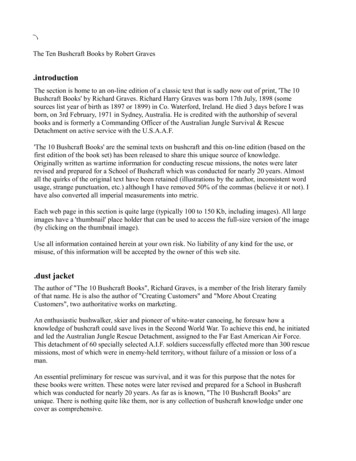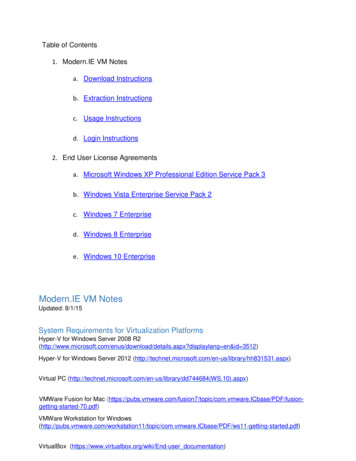
Transcription
The Ten Bushcraft Books by Robert Graves.introductionThe section is home to an on-line edition of a classic text that is sadly now out of print, 'The 10Bushcraft Books' by Richard Graves. Richard Harry Graves was born 17th July, 1898 (somesources list year of birth as 1897 or 1899) in Co. Waterford, Ireland. He died 3 days before I wasborn, on 3rd February, 1971 in Sydney, Australia. He is credited with the authorship of severalbooks and is formerly a Commanding Officer of the Australian Jungle Survival & RescueDetachment on active service with the U.S.A.A.F.'The 10 Bushcraft Books' are the seminal texts on bushcraft and this on-line edition (based on thefirst edition of the book set) has been released to share this unique source of knowledge.Originally written as wartime information for conducting rescue missions, the notes were laterrevised and prepared for a School of Bushcraft which was conducted for nearly 20 years. Almostall the quirks of the original text have been retained (illustrations by the author, inconsistent wordusage, strange punctuation, etc.) although I have removed 50% of the commas (believe it or not). Ihave also converted all imperial measurements into metric.Each web page in this section is quite large (typically 100 to 150 Kb, including images). All largeimages have a 'thumbnail' place holder that can be used to access the full-size version of the image(by clicking on the thumbnail image).Use all information contained herein at your own risk. No liability of any kind for the use, ormisuse, of this information will be accepted by the owner of this web site.dust jacketThe author of "The 10 Bushcraft Books", Richard Graves, is a member of the Irish literary familyof that name. He is also the author of "Creating Customers" and "More About CreatingCustomers", two authoritative works on marketing.An enthusiastic bushwalker, skier and pioneer of white-water canoeing, he foresaw how aknowledge of bushcraft could save lives in the Second World War. To achieve this end, he initiatedand led the Australian Jungle Rescue Detachment, assigned to the Far East American Air Force.This detachment of 60 specially selected A.I.F. soldiers successfully effected more than 300 rescuemissions, most of which were in enemy-held territory, without failure of a mission or loss of aman.An essential preliminary for rescue was survival, and it was for this purpose that the notes forthese books were written. These notes were later revised and prepared for a School in Bushcraftwhich was conducted for nearly 20 years. As far as is known, "The 10 Bushcraft Books" areunique. There is nothing quite like them, nor is any collection of bushcraft knowledge under onecover as comprehensive.
The term "Bushcraft" is used because woodcraft commonly means either knowledge of local faunaand flora or else is associated with the blood-sports of hunting and shooting.The traps and snares included in this book would be ineffective for native animals which are insectenters or grazers. These traps have been included because they would only be effective in catchingpredatory animals such as cats and dogs which have taken to the bush, and other "pest" creatures."Bushcraft" describes the activity of how to make use of natural materials found locally in anyarea. It includes many of the skills used by primitive man, and to these are added "white man"skills necessary for survival, such as time and direction, and the provision of modern "white man"comforts. The practice of bushcraft develops in an individual a remarkable ability to adapt quicklyto a changing environment. Because this is so, the activity is a valuable counter to today'sspecialisation, and particularly significant in youth training work.introductionThe practice of bushcraft shows many unexpected results. The five senses are sharpened, andconsequently the joy of being alive is greater.The individual's ability to adapt and improvise is developed to a remarkable degree. This in turnleads to increased self-confidence.Self-confidence, and the ability to adapt to a changing environment and to overcome difficulties,is followed by a rapid improvement in the individual's daily work. This in turn leads toadvancement and promotion.Bushcraft, by developing adaptability, provides a broadening influence, a necessary counter tooffset the narrowing influence of modern specialisation.For this work of bushcraft all that is needed is a sharp cutting implement: knife, axe or machete.The last is the most useful. For the work, dead materials are most suitable. The practice ofbushcraft conserves, and does not destroy, wildlife.R.H.G.list of bushcraft books Book 1. - Ropes & CordsBook 2. - Huts & ThatchingBook 3. - CampcraftBook 4. - Food & WaterBook 5. - FiremakingBook 6. - Knots & LashingsBook 7. - Tracks & LuresBook 8. - Snares & TrapsBook 9. - Travel & Gear
Book 10. - Time & DirectionIntroductionOne of the first needs in Bushcraft is the ability to join poles or sticks. The only method available is bythe use of lashings.To use lashings however, it is necessary to have, find or make materials for this purpose.The ability to spin or plait fibres into ropes or cords is one of the oldest of man's primitive skills. Themethod is simple and follows precisely the same stages that are made use of by today's complicatedmachines.The material from which to spin or plait ropes or cords is in abundance everywhere. Any fibrousmaterial which has reasonable length, moderate strength and is flexible or pliable can be used. Theseare the three things to look for and they can be found in many vines, grasses, barks, palms and even inthe hair of animals.The breaking strains of handmade ropes and cords varies greatly with different materials. Consequentlyit is essential that the rope or cord be tested for the purpose for which it will be used before beingactually put to use.The uses to which these hand-made ropes and cords can be put, apart from lashing, is almost endlessand some few are included in this book.the making of ropes and cordsAlmost any natural fibrous material can be spun into good serviceable rope or cord, and many materialswhich have a length of 12" to 24" [30 cm to 60 cm], or more, can be braided or plaited. Ropes of up to3" and 4" [7.5 cm and 10 cm] diameter can be 'laid' by four people, and breaking strains for bush-maderope of 1" [2.5 cm] diameter range from 100 lbs. [45 kg] to as high as 2,000 lbs. or 3,000 lbs. [905 kgor 1,360 kg].breaking strainsTaking a three lay rope of 1" [2.5 cm] diameter as standard, the following table of breaking strains mayserve to give a fair idea of general strengths of various materials. For safety sake always regard thelowest figure as the breaking strain unless you know otherwise.Green Grass100 lbs. to 250 lbs. [45 kg to 115 kg]Bark Fibre500 lbs. to 1,500 lbs. [225 kg to 680 kg]Palm Fibre650 lbs. to 2,000 lbs. [295 kg to 905 kg]Sedges2,000 lbs. to 2,500 lbs. [905 kg to 1,135 kg]Monkey Rope (Lianas) 560 lbs. to 700 lbs. [245 kg to 320 kg]Lawyer Vine (Calamus) ½" [1.25 cm] dia. 1,200 lbs. [545 kg]Double the diameter quadruples the breaking strain. Halve the diameter, and you reduce the breakingstrain to one fourth.
.principles of rope making materialsTo discover whether a material is suitable for rope making it must have four qualities: It must be reasonably long in the fibre.It must have 'strength'.It must be pliable.And it must have 'grip' so that the fibres will 'bite' onto one another.There are three simple tests to find if any material is suitable.First pull on a length of the material to test it for strength. The second test, to be applied if it hasstrength, is to twist it between the fingers and 'roll' the fibres together; if it will stand this and not 'snap'apart, tie a thumb knot in it and gently tighten the knot. If the material does not cut upon itself, butallows the knot to be pulled taut, then it is suitable for rope making, providing that the material will'bite' together and is not smooth or slippery.You will find these qualities in all sorts of plants, in ground vines, in most of the longer grasses, insome of the water reeds and rushes, in the inner barks of many trees and shrubs, and in the long hair orwool of many animals.Some green freshly gathered materials may be 'stiff' or unyielding. When this is the case try passing itthrough hot flames for a few moments. The heat treatment should cause the sap to burst through someof the cell structure, and the material thus becomes pliable.Fibres for rope making may be obtained from many sources: Surface roots of many shrubs and trees have strong fibrous bark;Dead inner bark of fallen branches of some species of trees and in the new growth of many treessuch as willows;In the fibrous material of many water and swamp growing plants and rushes;In many species of grass and in many weeds;In some sea weeds;In fibrous material from leaves, stalks and trunks of many palms;In many fibrous-leaved plants such as the aloes.gathering and preparation of materialsIn some plants there may be a high content of vegetable gum and this can often be removed by soakingin water, or by boiling, or again, by drying the material and 'teasing' it into thin strips.Some of the materials have to be used green if any strength is required. The materials that should begreen include the sedges, water rushes, grasses, and lianas.
Grasses, sedges and water rushes should be cut and never pulled. Cutting above ground level is'harvesting', but pulling up the plant means its 'destruction'.It is advisable not to denude an area entirely but to work over a wide location and harvest the mostsuitable material, leaving some for seeding and further growth.For the gathering of sedges and grasses, be particularly careful therefore to 'harvest' the material, thatis, cut what you require above ground level, and take only from the biggest clumps.By doing this you are not destroying the plant, but rather aiding the natural growth, since yourharvesting is truly pruning.You will find that from a practical point of view this is far the easiest method.Many of the strong-leafed plants are deeply rooted, and you simply cannot pull a leaf off them.Palm fibre in tropical or sub-tropical regions is harvested. You will find it at the junction of the leaf andthe palm trunk, or you will find it lying on the ground beneath many palms. Palm fibre is a 'natural' formaking ropes and cords.Fibrous matter from the inner bark of trees and shrubs is generally more easily used if the plant is deador half dead. Much of the natural gum will have dried out and when the material is being teased, priorto spinning, the gum or resin will fall out in a fine powder.There may be occasions when you will have to use the bark of green shrubs, but avoid this unless it isabsolutely essential, and only cut a branch here and there. Never ever cut a complete tree just becauseyou want the bark for a length of cord.to make cord by spinning with the fingersUse any material with long strong threads or fibres which you have previously tested for strength andpliability. Gather the fibres into loosely held strands of even thickness. Each of these strands is twistedclockwise. The twist will hold the fibre together. The strands should be from 1 8" [3 mm] downwards for a rough and ready rule there should be about 15 to 20 fibres to a strand. Two, three or four of thesestrands are later twisted together, and this twisting together or 'laying' is done with an anti-clockwisetwist, while at the same time the separate strands which have not yet been laid up are twistedclockwise. Each strand must be of equal twist and thickness.This illustration shows the general direction of twist and the method whereby thefibres are bonded into strands. In similar manner the twisted strands are puttogether into lays, and the lays into ropes. Illustrated in this diagram is a twostrand lay.The person who twists the strands together is called the 'layer', and he must see that the twisting iseven, that the strands are uniform, and that the tension on each strand is equal. In laying, he must watchthat each of the strands is evenly 'laid up', that is, that one strand does not twist around the other two.(A thing you will find happening the first time you try to 'lay up'.)When spinning fine cords for fishing lines, snares, etc., considerable care must be taken to keep the
strands uniform and the lay even. Fine, thin cords of no more than 1 32" [0.75 mm] thickness can bespun with the fingers and they are capable of taking a breaking strain of 20 lbs. to 30 lbs. [10 kg to 15kg] or more.Normally two or more people are required to spin and lay up the strands for cord.Many native people when spinning cord do so unaided, twisting the material by running the flat of thehand along the thigh, with the fibrous material between hand and thigh and with the free hand they feedin fibre for the next 'spin'. By this means one person can make long lengths of single strands.This method of making cord or rope with the fingers is slow if any considerable length of cord isrequired.A more simple and easy way to rapidly make lengths of rope of 50 yd. to 100 yd. [45 m to 90 m] ormore in length is to make a rope-walk and set up multiple spinners in the form of cranks. The series ofphotographic illustrations on the succeeding pages show the details of rope spinning.In a rope walk, each feeder holds the material under one arm and with one free hand feeds it into thestrand which is being spun by the crank. The other hand lightly holds the fibres together till they arespun. As the lightly spun strands are increased in length they must be supported on cross bars. Do notlet them lie on the ground. You can spin strands of 20 yd. to 100 yd. [20 m to 90 m] before laying up.Do not spin the material in too thickly. Thick strands do not help strength in any way, rather they tendto make a weaker rope.setting up a rope walkWhen spinning ropes of 10 yd. [10 m] or longer it is necessary to set cross bars every 2 yd. or 3 yd. [1.8m or 2.7 m] to carry the strands as they are spun. If cross bars are not set up the strands of rope will sagto the ground, and some of the fibres will tangle up with grass, twigs or dirt on the ground. Also thetwisting of the free end may either be stopped or interrupted and the strand will be unevenly twisted.The easiest way to set up crossbars for the rope walk is to drive pairs of forked stakes into the groundabout 6' [1.8 m] apart and at intervals of about 6' to 10' [1.8 m to 3 m]. The cross bars must be smooth,and free from twigs and loose portions of bark that might twist in with the spinning strands.The cross bar A is supported by two uprights, and pierced to take the cranks B. These cranks can bemade out of natural sticks, morticed slab and pegs, or if available, bent wire. The connecting rod Cenables one man to turn all cranks clockwise simultaneously. Crossbars supporting the strands as theyare spun are shown D. A similar crank handle to C is supported on a fork stick at the end of the ropewalk. This handle is turned in reverse (anti-clockwise) to the cranks C to twist the connected strandstogether. These are 'laid up' by one or more of the feeders.Always make it a rule to turn the first strand clockwise, then the laying up of the strands will be done
anti-clockwise and the next laying will again be clockwise.Bark fibre being spun into strandsusing a single crank handle.Spinner-feeder on right with bundleJoining the strands priorof material under his right arm feedsto lay up.in material.Testing the rope of bark fibre, breakingstrain 1" [2.5 cm] diameter, about 800 Close up of the finished rope.lbs. [365 kg].Proof that your rope is well made will be if the individual fibres lie lengthways along the rope.In the process of laying up the strands, the actual twisting together, or laying, will take some of theoriginal 'twist' out of the strand which has not yet been laid. Therefore it is necessary to keep twistingthe strands whilst laying together.When making a rope too long to be spun and laid in one piece, a section is laid up and coiled on theground at the end of the rope walk farthest from the cranks. Strands for a second length are spun, andthese strands are married or spliced into the strands of the first section and then the laying up of thesecond section continues the rope.The actual 'marrying' of the strands is done only in the last lay, which when completed makes the rope.The ends where the strands are married should be staggered in different places. By this means rope canbe made and extended in sections to a great length.After your complete length of rope is laid up, pass it through fire, to burn off the loose ends and fibres.This will make your rope smooth and most professional looking.laying the strandsThe strands lie on these crossbars as they are spun. When the strands have been spun to the requiredlength, which should be no more than about a 100' [30 m], they are joined together by being held at thefar end. They are then ready for laying together.The turner, who is facing the cranks, twists the ends together anti-clockwise, at the same time keepinghis full weight on the rope and which is being layed up. The layer advances placing the strands side byside as they turn.Laying up is very fast when the layer is experienced. He quickly gets the feeling of the work.
It is important to learn to feed the material evenly, and lay up slowly, thereby getting a smooth evenrope. Do not try to rush the ropemaking. If you do you will have uneven, badly spun strands, and uglylays, and poor rope. Speed in ropemaking only comes with practice. At first it will take a team of threeor four up to two hours or more to make a 50-yard [45 m] length of rope of three lays, each of threestrands, that is nine strands for a rope with a finished diameter of about 1" [2.5 cm]. With practice thesame three or four people will make the same rope in 15 to 20 minutes. These times do not include timefor gathering material.In feeding, the free ends of the strands twist in the loose material fed in by the feeder. The feeder mustmove backwards at a speed governed by the rate at which he feeds. As the feeder moves backwards hemust keep a slight tension on the strands.making rope with single spinnerTwo people can make rope, using a single crank.A portion of the material is fastened to the eye of the crank, as with the multiple crank, and the feederholding the free ends of this strand against the bundle of loose material under his arm feeds in, walkingbackwards. Supporting crossbars, as used in a ropewalk, are required when a length of more than 20' or30' [6 m or 9 m] is being spun.feedingIf the feeder is holding material under his left arm, his light hand is engaged in continuously pullingmaterial forward to his left hand which feeds it into the turning strand. These actions done together asthe feeder walks backwards govern the thickness of the strands. His left hand, lightly closed over theloose turning material, must 'feel' the fibres 'biting' or twisting together.When the free end of the turning strand, which is against the loose material under his arm, takes in toothick a tuft of the material he closes his left hand, and so arrests the twist of the material between hisleft hand and his bundle. This allows him to tease out the overfull 'bite' with his right hand, and so hemaintains a uniform thickness of the spinning strand. There is a knack in 'feeding' and once you havemastered this knack you can move backwards, and feed with considerable speed.thickness of strandsEqual thickness for each of the strands throughout their length, and equal twist are important. Thethickness should not be greater than is necessary with the material being used. For grass rope, thestrand should not be more than ¼" [6 mm] diameter; for coarse bark or palm not more than 1 8" or3 16" [3 mm or 4.5 mm]; for fine bark, hair or sisal fibre not more than 1 8" [3 mm].For cords the strand should be no more than 1 16" [1.5 mm] in diameter.Fine cords cannot be made from grass, unless the fibres are separated by beating out and 'combing'.The correct amount of twist is when the material is 'hard', that is, the twist is tight.faults common with beginnersThere is a tendency with the beginner to feed unevenly. Thin wispy sections of strand are followed bythick hunky portions. Such feeding is useless. Rope made from such strands will break with less thanone-quarter of the possible strain from the material.
The beginner is wise to twist and feed slowly, and to make regular, even strands rather than rush the joband try and make the strands quickly. Speed, with uniformity of twist and thickness, comes only withpractice. In a short time when you have the 'feel' of feeding, you will find you can feed at the rate offrom 30' to 60' [9 m to 18 m] a minute.Thick strands do not help. It is useless to try and spin up a rope from strands 1" [2.5 cm] or more inthickness. Such a rope will break with less than half the potential strain of the material.Spinning 'thick' strands does not save time in ropemaking.lianas, vines and canesLianas and ground vines are natural ropes, and grow in sub-tropical and tropical scrub and jungle.Many are of great strength, and useful for bridging, tree climbing and other purposes. The smallerground vines when plaited give great strength and flexibility. Canes, and stalks of palms provideexcellent material if used properly. Only the outer skin is tough and strong, and this skin will split offeasily if you bend the main stalk away from the skin. This principle also applies to the splitting oflawyer cane (calamus), all the palm leaf stalks and all green material. If the split starts to run off, youmust bend the material away from the thin side, and then it will gradually gain in size, and come backto an even thickness with the other split side.bark fibresThe fibres in many barks which are suitable for rope making are close to the innermost layer. This isthe bark next to the sap wood.When seeking suitable barks of green timber, cut a small section about 3" [7.5 cm] long, and 1" [2.5cm] wide. Cut this portion right from the wood to the outer skin of the bark.Peel this specimen, and test the different layers. Green bark fibres are generally difficult to spinbecause of 'gum' and it is better to search around for windfallen dead branches and try the inner bark ofthese. The gum will probably have leached out, and the fibres separate very easily.Many shrubs have excellent bark fibre, and here it is advisable to cut the end of a branch and peel off astrip of bark for testing. Thin barks from green shrubs are sometimes difficult to spin into fine cord andit is then easier to use the lariat plait for small cords.Where it is necessary to use green bark fibre for rope spinning (if time permits), you will find that thegum will generally wash out when the bark is teased and soaked in water for a day or so.After removing from the water allow the bark strips to partly dry out before shredding and teasing intofibre.
.plaitingOne man may require a considerable length of rope, and if he has no assistance to help him spin up hismaterial he can often find reasonably long material (say, from 1' to 3' [30 cm to 90 cm], or more) andusing this material he can plait (or braid) and so make suitable rope. The usual three plait makes a flatrope, and while quite good, has not the finish nor shape, nor is it as 'tight' as the four or lariat plait. Onother occasions it, may be necessary to plait broad bands for belts or for shoulder straps. There aremany fancy braids and plaits which you can develop from these, but these three are basic, and essentialfor practical woodcraft work.A general rule for all plaits is to work from the outside into the centre.Three PlaitTake the right-hand strand Take the left-hand strand and pass itand pass it over the strand to over the strand to the right and repeatthe left.alternately front left to right.Flat Four PlaitTake the outside left strand and putLay the four strands Now take the outsideit under and over the next twoTake what is nowside by side. Take the left-hand strand as instrands respectively movingthe outside rightright-hand strand as Fig. 2 and lay it undertowards the right. Thereafter yourhand strand and layin Fig. 1 and lay itthe next strand to itselfright-hand strand goes over oneit over the firstover the strand to the and over what was thestrand to the left, and your leftstrand to its left.left.first strand.hand strand under and over to theright, as shown in Fig. 4.
Broad PlaitTo commence take six,seven or more strands, andhold them flat and together.Take a strand in the centreand pass it over the nextstrand to the left, as in Fig.1.Take the second strand inthe centre to the left andpass it towards the rightover the strand you firsttook so that it pointstowards the right as in Fig.2.Now take the nextstrand to the first oneand weave it underand over as in Fig. 3.The finished plaitshould be tight andclose as in Fig. 7.Weave the next strandsfrom left and rightalternately towards thecentre as in Fig. 4, 5, 6.
.plaiting (cont.)To Finish OffAll the strands should beNow take the first strand Take a strand from the so woven back that noTake one of the centre which it enclosed inopposite side, and lay it strands show an unevenstrands, and lay it back being folded back, andback and weave itpattern, and there shouldupon itself as in Fig. 1. weave this back uponbetween the strandsbe a regular under-overitself as in Fig. 2.already plaited.under of the alternatingweaves.If you have plaited tightly there may be a difficulty in working the loose ends between the plaitedstrands. This can be done easily if you sharpen a thin piece of wood to a chisel edge, and use this toopen the strands sufficiently to allow the ends being finished to pass between the woven strands. Rollunder a bottle to work smooth after finishing off.Round Or Lariat Plait (Four Strands)Lay the four strandstogether side by side, asin Fig. 1, and cross theright-hand centre strandover, and then around theleft-hand strand.Take the left-hand outsidestrand and pass it over thetwo crossed strands, andthen under the right-handone of the two, so that it ispointing towards the left, asin Fig. 2.Take the free right-handstrand, and pass it over the Repeat this withtwo twisted strands to the the outside leftleft and completely round hand strand as inthe left-hand one of theFig. 4.two, as in Fig. 3.
Repeat with the right-handstrand as in Fig. 5.The finished plaitshould look likethis.testing your ropePrior to trusting your life to a bush-made rope, always test it. Tie one end to a tree and put three or fourfellows onto the other end. Have them take the strain gently until finally all their weight is on the rope.If they cannot break it, then it is safe for one man at a time to use it to climb or descend a cliff face.When climbing up a bush-made rope always use the footlock, and when descending never slide downthe rope. Climb down again using the same footlock.Ascent of a cliff face, using a footlock on a grass rope. The grass rope was 3 strand 3 layof 2" [5 cm] diameter.The footlock offers a measure of safety, and the climber is so secure that he can actually stand on therope and rest without his body weight being carried entirely on his arms. To prove this, use thefootlock, and clasp the rope to your body with your arms. You will find that you are 'standing' on therope and quite secure.By means of the footlock you can climb to any height on the rope, stopping to rest when your arms tire.
The footlock is made by holding onto the rope with both hands, lifting the knees, and kicking the ropeto the outside of one foot. The foot on the opposite side to the rope is 'pointed' so that the toe picks upthe rope, which is pulled over the foot which was against the rope, and under the instep of the footwhich 'picked' it up.The two feet are brought together, and the rope is now over the instep of one foot, and under the ball ofthe other. Then, to secure the grip, and lock the rope the feet are placed one on top of the other so thatthe rope is clamped down by the foot on top.By straightening the knees, and raising the hands, the body is lifted, and a fresh grip taken for the nextrise.In descending, the body is bent, the hands lowered, and the footlock released, and a fresh grip takenwith the feet at a lower level on the rope.It is advisable to wear boots or shoes when climbing bushmade ropes.This method of descending is much safer than sliding. In sliding there is grave risk of bad rope burns tohands and legs.
'absyle' for rock descentAbsyle used for descending rock face. This bush-made grass rope is 3 strand 3lay of about 2" [5 cm] diameter. Breaking strain approx. 900 lbs. [430 kg].The 'Absyle' is used for rock work, generally for descending, though it can be used on some facesfor ascent. In the 'Absyle' the body is up-right, but the legs are stretched out, and the feet pressedagainst the rock face.The rope passes down between the thighs, around one thigh and diagonally up and across theupper half of the body and over the shoulder opposite to the leg under which it passes. The ropemay be gripped with one hand.In descending, the free hand pulls the rope over the shoulder. This leaves a loop below the thigh,and the feet are 'walking' down the rock face until the thigh is again snug in the loop. The 'Absyle'used for descending makes it practically impossible to fall.In ascending a rock face which has an extreme slope but is not vertical, the feet are 'walked' up therock face, the body is pulled up the rope and the slack, hanging below the legs, is pulled up withone hand and fed over the shoulder. By this means the climber can 'sit' on the rope and rest. Whenusing the 'Absyle' it will be found that bare feet, sandshoes or spiked shoes give a better grip onthe rock face than pla
The Ten Bushcraft Books by Robert Graves .introduction The section is home to an on-line edition of a classic text that is sadly now out of print, 'The 10 Bushcraft Books' by Richard Graves. Richard Harry Graves was born 17th July, 1898 (some sources list year of birth as 1897 or 1899) in Co. Waterford, Ireland. He died 3 days before I was











